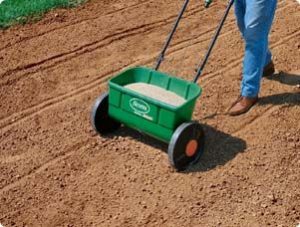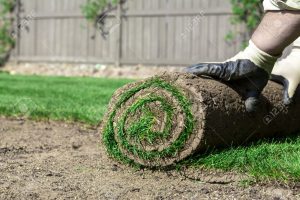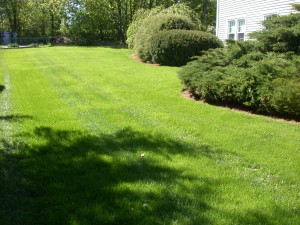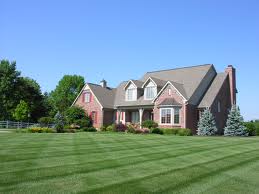 Ever wondered what it takes to have the perfect lawn? One of your neighbors probably has a lawn that is close. Do you wonder what is he doing that your not? Well, it turns out it is actually pretty easy to get a near-perfect lawn. Which will be the envy of your neighbors and friends. It really will not take that much work. Perfect lawns and lawn maintenance are easy to achieve. It just takes a little time and tender loving care.
Ever wondered what it takes to have the perfect lawn? One of your neighbors probably has a lawn that is close. Do you wonder what is he doing that your not? Well, it turns out it is actually pretty easy to get a near-perfect lawn. Which will be the envy of your neighbors and friends. It really will not take that much work. Perfect lawns and lawn maintenance are easy to achieve. It just takes a little time and tender loving care.
Perfect Lawns and Lawn Maintenance
The secret to the perfect lawn is regular care, regular watering when needed, regular fertilizer, cutting when the lawn has grown an inch or more and before it gets too long and keeping debris and weeds away from your lawn. We will cover these issues in detail, however, if you pay attention to these basics, your lawn will look great! All of these items are required, however, if you keep up with the work, you will not get overwhelmed and the lawn will look great. If you let it go for a few weeks, you may have a big job on your hands and that is no fun.
Fertilizer
Lawns need fertilizer at regular intervals. Even if you use a standard fertilizer without chemicals for killing weeds you will be away ahead in terms of a healthy lawn. The fertilizer companies offer specific fertilizers for the spring, the summer, and the late fall. We recommend that you use these fertilizers and put them on your lawn following the instructions that come with the fertilizer. You will have a nice green healthy lawn that will be better able to withstand dry spells and also fight off weeds.
Some fertilizers call for lots of water afterward while others require a dry spell. Either way, follow the instructions to avoid burning your lawn. Also, use a proper spreader and avoid spilling fertilizer on your lawn in concentrated amounts.
Weeds & Debris
Another trick to a healthy lawn is to keep the lawn clear of debris such as leaves, branches, and other material that might impede the growth of your lawn. Weeds seem to grow everywhere and are able to survive in the driest conditions. Many municipalities are cutting back on pesticides and limiting what you can purchase at stores to kill the weeds in your lawn.
For many people, this is a good thing, especially if you are concerned about getting sick from these chemicals. For the last two years, I have just carried a small blade with me to dig out dandelion roots and other weeds. So far I am ahead of the game. NO weeds, no chemicals, and less cost! I just dig them out as I see them while I am cutting the grass. It takes a little longer to mow the grass, but that is ok with me.
Water
Water is important for lawns, both too much and too little. Too much rain and you get mold, mushrooms, and rot in your lawn. Not enough and it gets dry, dead-looking, and very thin. These are excellent conditions for weeds to take over since they seem to thrive in all conditions. If your lawn is looking dry give it a good watering so that the roots get a chance to replenish the roots and the blades above ground. Let the grass grow a bit longer before cutting it to provide more protection and guard against evaporation. If water is inexpensive and not limited by the city, water every day in the evening. This ensures less evaporation and more water for the grass.
A strong root system, deep in the soil, and a thick mat will ensure that your lawn can withstand dry spells longer. When it is growing quickly, cut it often, when it is growing slowly cut it less often and allow it to grow a bit longer than you normally wood.
Cutting Your Lawn
We talked a little bit about cutting your lawn earlier in this post. Never allow your lawn to get too long without cutting it. It is hard on the grass, hard on your lawnmower, and more work for you if you have to cut grass that has grown too long. Cut it more often so the lawn can easily recover unless you are going through a real dry spell and you do not want to water your lawn.
Make sure your mower blade is sharp and not tearing the lawn. This makes for a nice even looking cut and a more tailored look.
Mulching, bagging, or leaving the Grass Clippings
There are many opinions about whether you should mulch, bag or allow your grass clippings to mix in with the grass. Bagging your grass is the most work and your city needs to collect the grass weekly or you need someplace to dispose of it.
Mulching your grass as you cut it means you are leaving the grass on the lawn in very small particles. It will disintegrate quickly allowing the nutrients to go back into the lawn. The mulch also insulates the lawn and provides protection from evaporation as well as makes it more difficult for weeds to grow. The only drawback of mulching is really that you should cut the lawn more often than normal since a long grass lawn is very difficult to cut while mulching. Your lawnmower can do a really good job and you will also not have obvious lawn clippings on your lawn.
The same goes for just leaving the grass clippings on the lawn, Cut it often to avoid having to rake the lawn. Sometimes when cutting a lawn that has been allowed to grow too long, the grass will coat the lawn and block the lawn from getting any light. Cut often and you will have a great lawn minus the weeds.
Perfect Lawns and Lawn Maintenance
In summary, cut often unless it is dry, do not cut it too short, fertilize 4 times a year following the proper instructions, keep the weeds down even if you have to dig them out yourself, keep the lawn clear of debris such as leaves and water often enough depending on local conditions to maintain a healthy lawn. Please feel free to leave your tips regarding keeping a healthy lawn!
For more posts about lawn care and having the perfect lawn, click here.
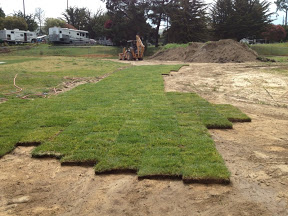 Can you lay sod in cold weather? What if there is snow on the ground already? It turns out that laying sod in the cold weather not outrageous at all. Cold is not the enemy. Rather it is heat and lack of water that can be the enemy of newly laid sod. Heat will dry out newly laid sod quickly, especially in hot dry weather. If you do not water the sod, the roots are going to quickly dry out and die. With no nourishment or moisture the grass quickly dries out, turns brown and dies. In cold weather, not freezing or frozen weather it can survive and even slowly put down roots into the soil below.
Can you lay sod in cold weather? What if there is snow on the ground already? It turns out that laying sod in the cold weather not outrageous at all. Cold is not the enemy. Rather it is heat and lack of water that can be the enemy of newly laid sod. Heat will dry out newly laid sod quickly, especially in hot dry weather. If you do not water the sod, the roots are going to quickly dry out and die. With no nourishment or moisture the grass quickly dries out, turns brown and dies. In cold weather, not freezing or frozen weather it can survive and even slowly put down roots into the soil below.

